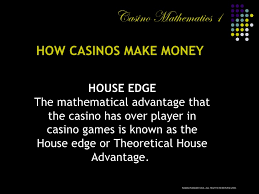Trading Edge
‘An edge is nothing more than an indication of a higher probability of one thing happening over another’.
When trading the markets it is important to have identified and understand what’s known as a trading edge.
A trading edge in the financial markets can be described as ‘a set of conditions that when present, give a higher probability of a trade working than not working’.
Casinos make large profits because all their games have a built-in mathematical edge on their side. This means that over the long-term they will make more money than they lose. If you don’t have an edge i.e. a long-term mathematical advantage, the best you can hope to do is break even.
However, in trading you won’t even get that far because the odds are stacked against you to begin with due to commission costs, spread, slippage, and not least emotions. Without an advantage you will lose money slowly, or all at once.

In the context of trading, an edge is a system that has been defined and tested rigorously, such that when it is applied it is found to make more money than it loses hence providing an advantage and potential trading opportunities.
The window of opportunity will vary depending on the edge characteristics and the time frame being traded, but generally the lower the time frame the shorter the window of opportunity.
Despite having an edge, there will be losing trades as well as winning trades since the outcome of trades are never a dead cert, but probability is on your side.
What this means in practice is that losing trades are part of the game, but so long as you exercise patience, wait for your trading edge to form and apply a consistent set of rules and proper money management, it is possible to achieve profitability.
Depending on the money management rules you apply, it is possible to achieve profitability even if you only have a 50% strike rate.
For example, if you apply 2R money management rules where the profit target is always twice the amount risked, you only need to be right 1 in every 3 trades to break even, this equates to a 33% strike rate.
Therefore allowing for broker costs, a 50% strike rate will result in a positive equity curve.
UK based traders benefit from the current legislation where all profits made from spread betting are tax free.
This means that a strike rate of 40% when targeting 2R trades is going to result in a positive equity curve, as demonstrated in the Blackbox Trading Edge section.
Obviously, the trading edge applied must be tried and tested for this to be the case, which can be done using a trading simulator and practiced on a demo account. This learning phase is a vital part of the process on your trading journey and if skipped is unlikely to result in a successful outcome.
Using 2R serves as a baseline to explain something that can also be called a ‘Positive Traders Equation’. However, when using the Price Action Grid it’s possible to take trades that can result in multiple R winners.
Below are two videos by entrepreneur, peak performance trainer and stocks/FX trader Adam Khoo that relate to professional trading.
The first video does a superb job of explaining how casinos make money due to their built-in mathematical edge. He explains the concepts of Risk-Reward and how you can use this principle when trading to give yourself the same advantage as a casino.
The second video follows on and compliments the first as he explains how in trading you need to have a probabilistic mindset, implement good money management strategies and think in terms of Risk-Reward and Rvalue, to achieve profitability.
The theory itself is simple, the challenge for us as traders is to have the patience to wait for high probability trade setups where our edge is in play and to trade them with consistency, time and time again.
